The Lowell Girls
This iCue Mini-Documentary presents the textile industry in Lowell, MA, as representative of the transition of American girls from the farms to the factories.
This feature is no longer available.
This iCue Mini-Documentary presents the textile industry in Lowell, MA, as representative of the transition of American girls from the farms to the factories.
This feature is no longer available.
Anti-alcoholism cartoons like this one, which depicts the nine steps of the "drunkard's progress," were widespread in the 19th century. Josh Brown of the American Social History Project explains why.
This feature is no longer available.
This iCue Mini-Documentary describes how the discovery of gold in California in 1848 led to an unprecedented migration, as thousands of people traveled west in the hopes of making it big.
This feature is no longer available.
This iCue Mini-Documentary uses two contemporary cartoons of the 1850s to illustrate the way in which many Southerners rationalized the institution of slavery as somehow being positive for blacks.
This feature is no longer available.
This iCue Mini-Documentary describes how, even though slavery is abolished after the Civil War, the system of share-cropping quickly emerged that kept blacks in a condition much like slavery.
This feature is no longer available.
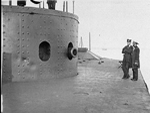
This lesson guides students through close analysis of a photograph of a piece of Civil War artillery as a means of better understanding the relationship between the Civil War and industrialization.
This lesson provides an excellent opportunity to teach students how to analyze historical photographs. Focusing on one photograph of a piece of Civil War artillery (though making use of a variety of other images), the lesson guides students step by step in carefully analyzing various elements of the photograph. Different portions of the image are isolated, and students answer questions about details in that portion of the image. Some questions may be difficult for students, and even teachers, to answer on their own, but answers to the questions are provided. This portion of the process would be a great opportunity for teachers to encourage students to make educated guesses in response to the more difficult questions before checking their answers.
While the lesson focuses on one particular photograph, it includes a remarkably useful collection of Civil War photographs to provide context for the featured image. We especially like the encouragement given students to re-evaluate their conclusions about the first image after looking at subsequent pictures. Openness to new evidence and new conclusions is an attitude that is important for students of history to maintain.
In addition to being a great lesson for teaching close analysis, this lesson also provides an excellent link between a single source and a much larger theme. It bridges two important topics in American history—the Civil War and Industrialization. The lesson concludes with a class discussion surrounding a set of questions about how the process of industrialization influenced the way in which the Civil War was waged. So often in our classrooms, historical events and themes turn into discrete, isolated units; this lesson provides a valuable reminder that all of the periods and events we study are interconnected: students have the opportunity to see how industrialization influenced the process and outcome of the war, and perhaps even how the war in many ways drove industrialization.
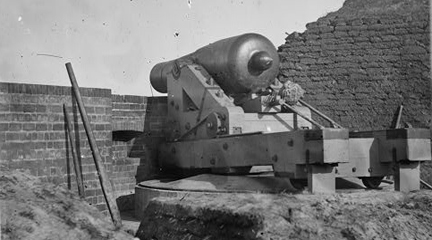
Yes
Yes
In addition to providing answers to specific questions about the photograph, the lesson includes both text and additional photographs to help place the featured photograph in context.
Yes
While no specific writing requirement is included, the questions about the photograph, as well as the discussion questions, can be used as writing prompts.
Yes
Yes
There is only minimal reading with the lesson, but the process does require close analysis of photographic sources.
Yes
Yes
The featured photograph is broken down into multiple sections, with built-in questions to guide students through analysis of each section.
No
While possible assessment strategies are mentioned, no specific assessment tools or assessment criteria are included. Wrap-up discussion questions used as writing prompts, however, would provide a useful assessment of student understanding.
Yes
Yes
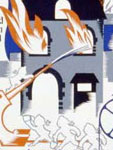
Students use a variety of primary source documents and a structured discussion process to understand the events and conditions surrounding the Triangle Shirtwaist Factory fire of 1911.
One of the greatest strengths of this lesson is its wealth and variety of primary sources. In addition to firsthand narrative accounts, the site also includes many photographs and political cartoons for students to analyze. Another strength is the way the lesson engages students in discussing sources with each other: students share their perceptions with one another after each step of document analysis, and then comment on one another's perceptions—setting the stage for lively historical discussion and debate.
Students begin the lesson by taking a brief opinion poll regarding industrialization, organized labor, and economic justice. At the end of the lesson students take the same poll, and discuss with their peers how their perceptions have changed as result of what they learned during the lesson.
Many of the text documents are long and may be challenging for some students, though some, like "Days and Dreams" by Sadie Frown would be relatively accessible to a high school student, or an advanced middle school student. It is written in narrative style, in simple language, and is of a moderate length. Other documents may need adaptation to meet student reading levels. However, the lesson also contains a sizeable collection of political cartoons, photographs, and other images. These could very easily form the central focus of the lesson, providing lots of material for students to discuss with one another.
Most of the documents (particularly the photos and cartoons) clearly condemn the factory owners. There is one account of the fire from the factory owners' point of view, in step five, which is listed as an "extra document," but one that is "strongly recommended." We echo that recommendation as this document allows students to see an alternative point of view on the event.
While students use primary sources as a vehicle for reshaping their initial hypotheses about industrialization, organized labor, and economic justice, information about the circumstances of each source's creation is not always readily available to students. Where this is the case, we recommend that teachers encourage students to use the source's content to identify the perspective of its author.
Overall, this is a good lesson that provides a useful tool in highlighting for students how their perceptions of history can change after exposure to a large mass of evidence. Often when teaching students the historical process, it is helpful to focus on just one aspect of historical thinking; otherwise students easily become overwhelmed. This lesson does just that: it helps students to focus on their own changing perceptions as they encounter the documents—an essential element of historical thinking.
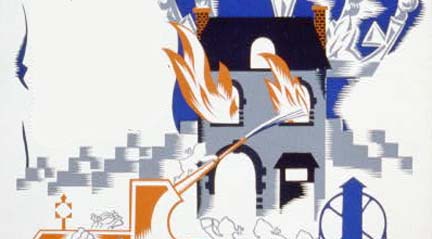
Yes
Yes
A wealth of background information is available from the Cornell University website on the Triangle Factory Fire.
Yes
The lesson requires significant reading; there are many opportunities for teachers to insert writing activities as well. The second part of the assessment would be one ideal place.
Yes
Students analyze sources in an effort to refine their interpretation of the events at the Triangle Shirtwaist Factory.
No
Some source information is included with the documents, and teachers can add a requirement that students note the creator and date of the source's creation.
Yes
No
Some additional adaptation of documents and reading aids may be necessary for your students. Students may especially need help with reading the political cartoons closely—see this guide for ideas.
Yes
The second part of the assessment, in which students create contents for a time capsule and must determine how the factory fire ought to be remembered, is especially strong. Its multiple parts allow you to easily tailor it for your students.
No assessment criteria are included.
Yes
Yes
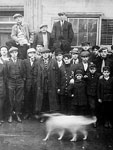
Access primary sources, activities, instructional tips, and assessments for a unit on the Progressive Era.
This unit on the Progressive Era consists of seven teaching activities, which build upon each other and culminate in an optional service learning project exploring modern day progressivism. Each part of the unit can be downloaded as an individual PDF, or the entirety can be downloaded at once. Overall, the complete package is age-appropriate, while also challenging students to develop historical thinking skills.
Activities 3, 4, and 5 utilize primary source documents and photographs, and ask students to analyze documents and draw conclusions from them. Activity 3, for instance, prompts students to examine child labor and its impact by looking at two collections of photographs—Kids at Work and Kids on Strike. It then asks students to consider questions such as "How did the people that wrote these books put their stories together?" and "What sources did they use to be successful history detectives?"
While each part of this lesson builds on the last, teachers can pick and choose among the seven activities. For teachers looking for more direction, the lesson includes a narrative script that can be used to frame each activity. It also includes a vocabulary list, a student learning chart/grading rubric, and a collection of links to selected websites.

Yes
Yes
A brief overview of historical background for each activity is included in the "Narrative Flow, Teachers' Background."
Yes
Students are asked to read primary documents, and there are opportunities for original student writing based on document analysis.
Yes
Yes
The unit includes close analysis of both text and photographic primary sources.
Yes
The scaffolding is very well-done, including student-friendly language and examples.
Yes
The process for each activity is clear.
Yes
A rubric is included that focuses on both content goals and process goals.
Yes
The rubrics are divided into content and process goals.
Yes
Lesson is also open to teacher adaptation.
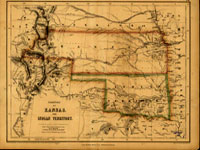
These Territorial Kansas collections convey the growing divisions in Kansas and the nation over the expansion of slavery, federalism, nationalism, industrialization, and changing political coalitions in Congress. Materials include government documents, diaries, letters, photographs, maps, newspapers, rare secondary sources, historical artifacts, and images of historic sites. The website is divided into five sections: Territorial Politics and Government; Border Warfare; Immigration and Early Settlement; Personalities; and National Debate about Kansas. Each is searchable by keyword, author, and county. Topical sections are subdivided into relevant themes and include an introductory essay. Visitors will find essays on territorial politics, the rights of women and African Americans, military organizations, and free state and pro-slavery organizations. "Personalities" lists 32 individuals, including John Calhoun, and the final section presents both anti-slavery and pro-slavery perspectives of the national debate about Kansas. The site also includes a timeline with links and an annotated bibliography.